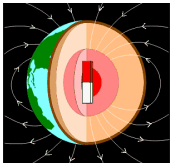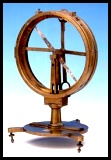
 Too Big For Your Pocket, But a Magnet Nonetheless The Earth's magnetic field is shaped somewhat like that of a bar magnet. It has two magnetic poles, one in the Canadian Arctic (called the North Magnetic Pole), and one off the coast of Antarctica (called the South Magnetic Pole). At the North Magnetic Pole (NMP) the Earth's magnetic field is directed vertically downward to the Earth's surface. Magnetic "dip", or inclination, is 90°, and that will be your eventual destination if you follow the direction of your compass needle from anywhere on Earth.
Now for the goofy part - the end of a bar magnet at which the magnetic field is directed outward is termed the "north" pole, and the end at which the magnetic field is directed inward is termed the "south" pole. The Earth's magnetic field is directed downward in the northern hemisphere and upward in the southern hemisphere. This implies that the "north" magnetic pole in the Arctic is really a "south" pole - and the "south" magnetic pole in Antarctica is really a "north" pole. However, by long custom and because people had already named the geographic poles before they figured out all that "magnetism" stuff, the magnetic poles are named to match their geographical neighbours (nobody wanted to change all of those maps). Anyway, it's believed that the poles can move so much that they can actually change. In another 100,000 years or so, the magnetic poles could flip.
Click pictures for more information and credits. Library: Arctic, Exploration, Explorers Northern Lights Franklin Expedition Links: Arctic, Northern Lights Franklin Expedition Arctic Maps & Weather Reports Northern Lights Slide Show |

|
DICTIONARY: Just "double-click" any unlinked word on this page for the definition from Merriam-Webster's Student Electronic Dictionary at Word Central. |

|
ARCTIC LIBRARY & GLOSSARY: Check this section for an index of the rest of the things you really need to know about the Arctic. |

|
ARCTIC MAPS & WEATHER REPORTS: Maps of the Northwest Passage, explorers' routes, iceberg sources, Nunavut, the Arctic by treeline, temperature... |

|
ARCTIC LINKS: Even more information! Links to sites related to the Arctic and "Iceberg: the Story of the Throps and the Squallhoots". |

|
GUIDE TO ARCTIC SUNRISE & SUNSET: How much sunlight or darkness is there in the Arctic on each day of the year? |
to is the property of their respective owners, and Athropolis is not responsible for their content.
